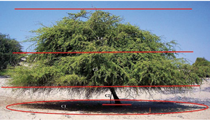Use and selection of the aerial parts of the carob tree Prosopis pallida (Fabaceae) by reptiles, birds and mammals in Sechura (Piura - Peru)
DOI:
https://doi.org/10.15381/rpb.v26i1.15417Keywords:
Desert fauna; dry forest; resource selection; Sechura desert; vegetal ecology.Abstract
Prosopis pallida is one component of the carob trees of the Sechura desert in northwestern Peru. It offers multiple benefits as a resource for wildlife. Following the concept of resource selection, the objective is to determine the use and selection of the aerial parts of the P. pallida by reptiles, birds and mammals, in the carob trees next to the lagoon Ñapique (Sechura, Peru). The data were taken in six conveniently selected transects and the availability of the tree was calculated after dividing it into three components, top cup, bottom cup and trunk with branches. To these components, the shade under the cup was added as the fourth component to be directly related with the tree. The Type I Design of Manly was adapted (availability and use are estimated for all individuals of the species within the study area) and the Manly Selection Ratio was used to determine the selection of tree components by wildlife. The reptiles selected the shade under the cup. Birds and mammals selected the trunk and branches. The use and selection of the different components of the P. pallida reveal the vital importance it has for the survival of wildlife in the Sechura Desert.
Downloads

Downloads
Published
Issue
Section
License
Copyright (c) 2019 Leticia Cruzado Jacinto, César Lautaro Chávez-Villavicencio, Jesús Manuel Charcape-Ravelo

This work is licensed under a Creative Commons Attribution-NonCommercial-ShareAlike 4.0 International License.
AUTHORS RETAIN THEIR RIGHTS:
a. Authors retain their trade mark rights and patent, and also on any process or procedure described in the article.
b. Authors retain their right to share, copy, distribute, perform and publicly communicate their article (eg, to place their article in an institutional repository or publish it in a book), with an acknowledgment of its initial publication in the Revista Peruana de Biologia.
c. Authors retain theirs right to make a subsequent publication of their work, to use the article or any part thereof (eg a compilation of his papers, lecture notes, thesis, or a book), always indicating its initial publication in the Revista Peruana de Biologia (the originator of the work, journal, volume, number and date).





